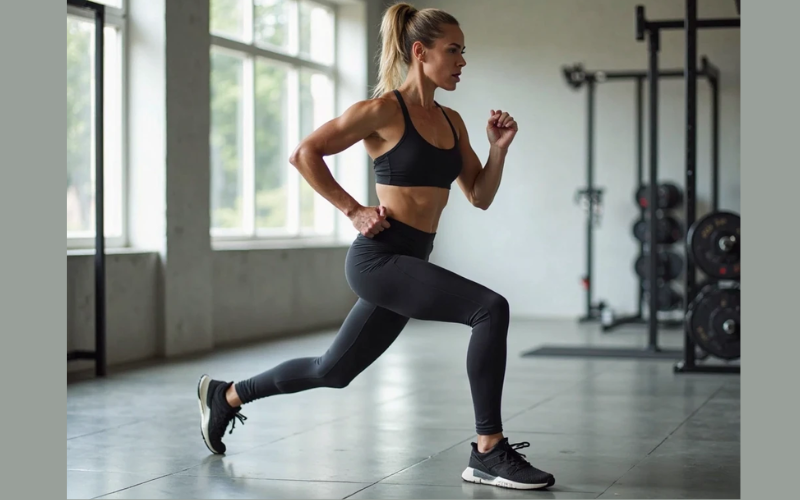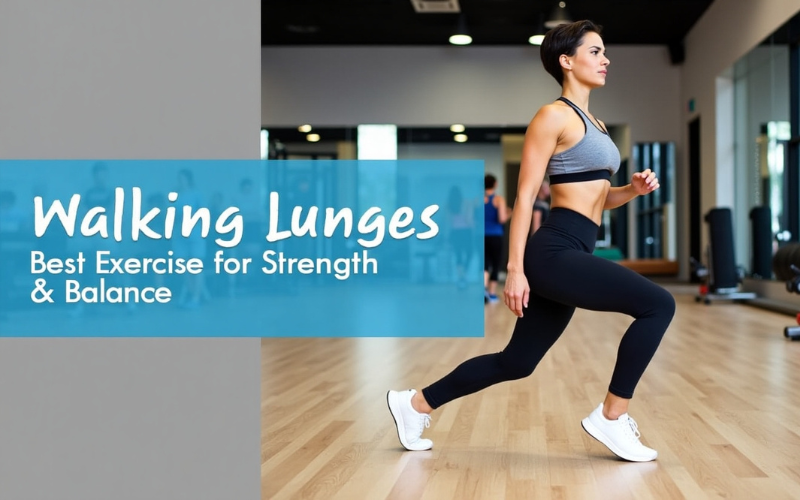When it comes to building lower-body strength, improving balance, and enhancing flexibility, few moves are as effective as walking lunges. These dynamic, compound exercises target multiple muscle groups at once, making them a staple in functional training routines. Whether you’re working out at home or hitting the gym, exercises like walking lunges are suitable for beginners and seasoned athletes alike.
Table of Contents
How to Do Walking Lunges Correctly
Performing walking lunges with correct form is crucial to avoid injuries and maximize benefits. Follow these step-by-step instructions:
- Start Position: Stand tall with feet hip-width apart.
- Step Forward: Take a big step forward with your right leg.
- Lower Down: Bend both knees until the front thigh is parallel to the ground and the back knee nearly touches the floor.
- Push Up: Push through your front heel to bring your left leg forward into the next lunge.
- Repeat: Continue stepping forward, alternating legs with each step.
Tip: Keep your torso upright, core engaged, and front knee in line with your ankle.
Popular Variations of Walking Lunges
To add variety and increase intensity, try these effective walking lunge variations:
- Reverse Walking Lunges: Step backward instead of forward, which reduces pressure on the knees.
- Side Lunges: Work the inner and outer thighs by stepping to the side.
- Walking Lunges with Dumbbells: Add resistance for muscle growth.
- Twisting Lunges: Rotate your torso at the bottom of the lunge to engage your core.
These variations keep your workouts fresh and challenge your body in new ways.
Muscles Targeted by Walking Lunges

Walking lunges are a powerhouse lower-body move that targets:
- Quadriceps (front of thighs)
- Gluteus maximus (buttocks)
- Hamstrings (back of thighs)
- Calves
- Core muscles (for stability)
This makes walking lunges a functional, full-leg workout that supports athletic performance and daily movement patterns.
Top Benefits of Walking Lunges Exercise
Here’s why exercises walking lunges are a go-to in strength and fitness training:
✅ Improved Balance and Coordination: You need stability with each step, which challenges your balance.
✅ Leg and Glute Strength: Builds strength and definition in your thighs and buttocks.
✅ Functional Movement Training: Mimics everyday motions like walking, climbing, and bending.
✅ Low Equipment Requirement: You can do walking lunges anywhere, even without weights.
✅ Core Activation: Your abdominal muscles engage to keep your body upright and aligned.
Common Mistakes to Avoid
Avoiding these common errors can prevent strain and improve results:
❌ Leaning Forward: Keep your chest lifted to avoid excess pressure on your knees.
❌ Letting Your Knee Go Past Your Toes: This can lead to knee discomfort or injury.
❌ Taking Shallow Steps: Ensure your step is long enough for proper depth.
❌ Rushing the Movement: Walk slowly to focus on form and muscle engagement.
Correct technique is more important than speed or weight when performing lunges.
Walking Lunges Safety Tips for Beginners
If you’re new to walking lunges, keep these safety tips in mind:
- Warm Up First: Light cardio or mobility drills help prepare the muscles and joints.
- Use a Mirror: Check your form to avoid misalignment.
- Start Without Weights: Master the basic movement before adding resistance.
- Avoid If You Have Knee Pain: Modify or consult a physiotherapist for safer alternatives.
How to Add Walking Lunges to Your Workout Routine
Here’s how to integrate lunges into your existing plan:
✅ Reps & Sets: Start with 2–3 sets of 10–12 steps per leg.
✅ Frequency: 2–3 times per week for lower body training.
✅ Superset with Squats or Deadlifts: For an intense leg day.
✅ As a Finisher: Walking lunges at the end of a workout burn calories and improve endurance.
You can perform walking lunges as part of leg day, full-body circuits, or HIIT sessions.
FAQs About Walking Lunges Exercise
Q1: Can walking lunges help with weight loss?
Yes. Walking lunges burn calories and build muscle, which helps boost metabolism over time.
Q2: Are walking lunges good for beginners?
Absolutely! Start with bodyweight lunges and increase intensity gradually.
Q3: How many walking lunges should I do in a day?
It depends on your fitness level. Beginners can start with 20–30 total reps, while advanced exercisers may aim for 100+.
Q4: Can walking lunges replace squats?
They complement squats but shouldn’t fully replace them. Squats focus on bilateral strength, while lunges add balance and unilateral focus.
Q5: What if I feel pain during lunges?
Stop immediately. Evaluate your form and consult a fitness professional if pain persists.
Final Thoughts: Why You Should Add Walking Lunges to Your Fitness Plan
Walking lunges are one of the best leg-toning and balance-building exercises available. Whether you’re trying to strengthen your glutes, sculpt your thighs, or improve your mobility, incorporating walking lunges exercises into your routine will provide incredible results with minimal equipment. Start small, stay consistent, and watch your lower body transform over time.
Ready to build stronger legs and better balance? Try walking lunges in your next workout and feel the difference!
💪 Explore fitness supplements & gear at https://nutritionalworld.com.pk/


























